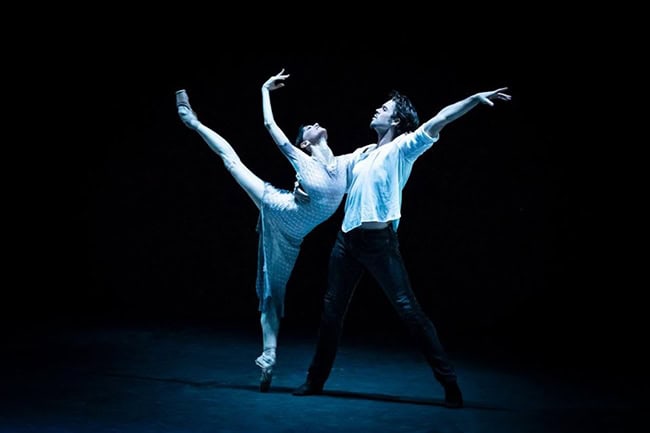Ballet Icons Gala at London Coliseum
Posted: February 5th, 2020 | Author: Nicholas Minns | Filed under: Gala | Tags: Akram Khan, Alberto Alonso, Alyona Kovalyova, Angelin Preljocaj, Annabelle Lopez Ochoa, Artem Ovcharenko, Ballet Icons Gala, Claudio Coviello, Daniil Simkin, Edwaard Liang, Ekaterina Kondaurova, Ekaterina Krysanova, Ensemble Productions, Erina Takahashi, George Balanchine, Giuseppe Picone, Iana Salenko, James Stout, James Streeter, Jason Kittelberger, Jocelyn Pook, Julian MacKay, Lucía Lacarra, Luisa Ieluzzi, Maia Makhateli, Marcelino Sambé, Maria Alexandrova, Matthew Golding, Natalia Osipova, Nicolette Manni, Timur Askerov, Valery Ovsyanikov, Vittoria Valerio, Vladislav Lantratov, Xander Parish, Yasmine Naghdi | Comments Off on Ballet Icons Gala at London ColiseumBallet Icons Gala, London Coliseum, January 26

The Ballet Icons Gala, presented by Ensemble Productions at the London Coliseum, is celebrating its fifteenth year; for lovers of dance, it is an annual feast for the senses with thirteen works and twenty-six dancers to savour. The gala is founded on the symbiotic nature of ballet icons; choreography, whether classical or contemporary, becomes iconic through performance, and dancers become iconic through their interpretation. When La Scala Ballet’s Principal, Nicoletta Manni, displays her innate musicality by matching the technical perfection of her fouettés in the coda of the Don Quixote pas de deux with the galloping rhythm provided by the ENB Philharmonic under Valery Ovsyanikov, it is memorable; the marriage of choreography and music is at the heart of classical ballet, and the pure sensation of Manni’s artistry is worth the ticket. The surprise is that this doesn’t happen more often; despite the company pedigree on display, the interpreters of the classical ballet extracts tend to be underwhelming. Timur Askerov and Ekaterina Kondaurova are both principals of the Mariinsky Theatre, but their star quality is missing in Victor Gsovsky’s Grand Pas Classique. The Royal Ballet field Yasmine Naghdi and Marcelino Sambé in the second act pas de deux from Giselle but from the moment Naghdi enters the game is lost. Against a gaudy backdrop that removes any sense of the uncanny, Giselle’s appearance is more macabre than ethereal. Naghdi’s steps are accented into the ground and when Sambé bounces on for his solo he has seemingly forgotten his repentance and is determined to thrill the audience. In Don Quixote, Manni is partnered by the youthfully gallant Julian MacKay, but the gallantry is not present in the way he attacks his steps; when virtuosity conveys visible effort over refinement, ballet loses its classicism. And when the refinement is more a stylistic trait than the culmination of technique, as in the performance of the final act pas de deux from Sleeping Beauty by Bolshoi principals Ekaterina Krysanova and Artem Ovcharenko, emotion is effectively excised from the motion. It is only in the final pas de deux from Le Corsaire by Iana Salenko and Daniil Simkin — both currently principals of Staatsballett Berlin — that the sparks worthy of a gala begin to fly. Simkin flirts with excess — perhaps it is this flirtation that makes his presence so fascinating — but his seemingly effortless virtuosity leaves traces of perfection. Salenko is well matched in energy and technical ease — her fouettés are so centred she finds it hard to stop — and the pair bring the performance to a climactic end.
While all the dancers in the Ballet Icons Gala are classically trained, some of the works are either neo-classical or contemporary. In Balanchine’s Diamonds pas de deux from Jewels, Alyona Kovalyova and Xander Parish pay elegant homage to the Russian tradition in which they — and Balanchine — were trained, while the extract from Alberto Alonso’s Carmen sees Maria Alexandrova replace fire with guile, leaving her fiery partner Vladislav Lantratov as José without a flame. One of the great exponents of classical ballet, Natalia Osipova, finds herself in an ambivalent dynamic with Jason Kittelberger in the world première of his Once with. Set to piano studies by Jean Sibelius, the duet sees them in a ‘physical conversation devoid of language miscommunication’. Kittelberger is clearly at home with the movement he creates on himself, but Osipova is still adapting to a physical communication that seems to hold her back from fully expressing herself. La Scala’s Vittoria Valerio and Claudio Coviello do not hold back from Angelin Preljocaj’s intoxicating language in the brief duet from Le Parc that makes the adagio from Mozart’s Piano Concerto No. 23 even more achingly beautiful, but the world première of Giuseppe Picone’s Elegie that he dances with Luisa Ieluzzi, shows how seductive language can so easily become self-indulgent. Annabelle Lopez Ochoa’s duet from Frida, performed by Dutch National Ballet’s Maia Makhateli and James Stout, struggles for context in this gala setting, all the more so because the relationship between Frida and Diego Rivera seems undercooked, while the duet from Akram Khan’s Dust is danced with such passion and conviction by English National Ballet’s Erina Takahashi and James Streeter that its wartime context, signified in Jocelyn Pook’s haunting score, is entirely subsumed. But it’s the audience’s lavish applause for Edwaard Liang’s Finding Light that suggests the interpretation by Lucía Lacarra and Matthew Golding of the dynamic shapes and intimate undulations of Liang’s choreographic relationship is so complete that we are witness to how an icon is created.